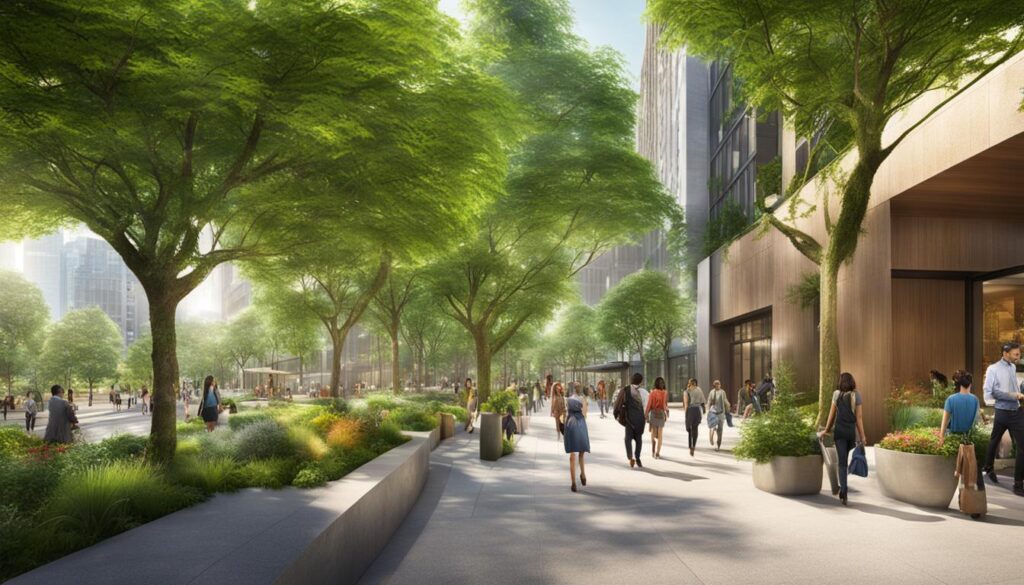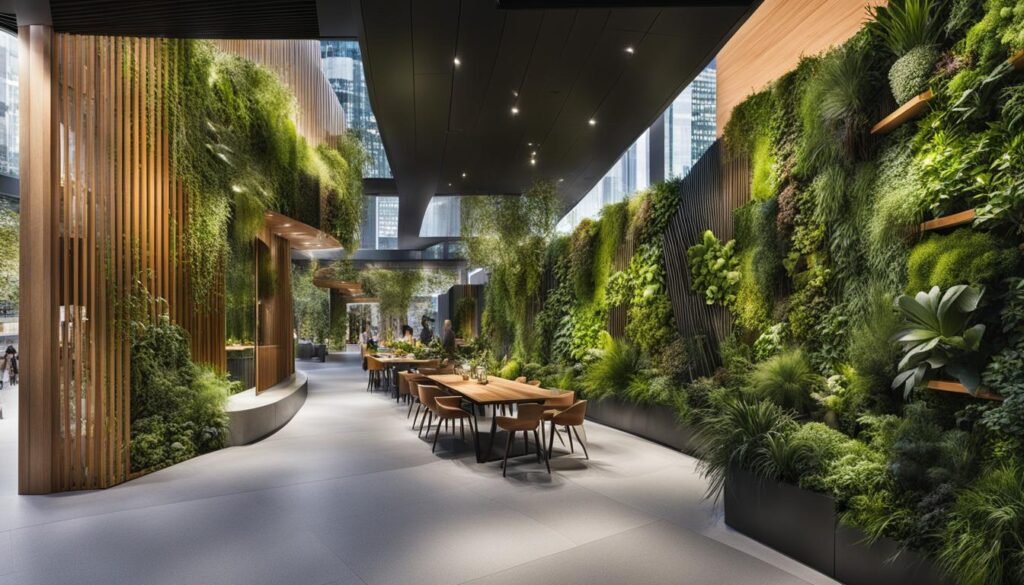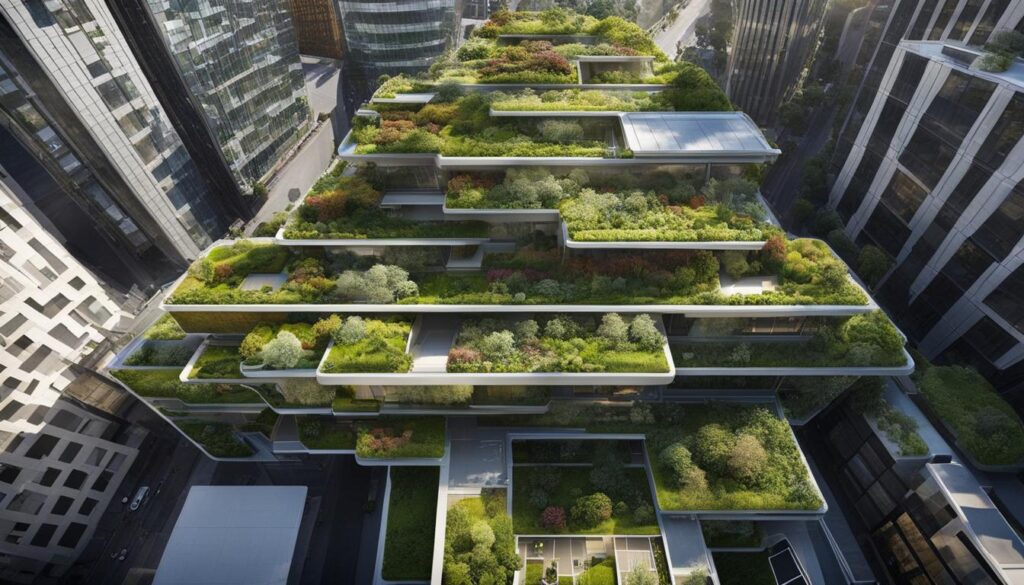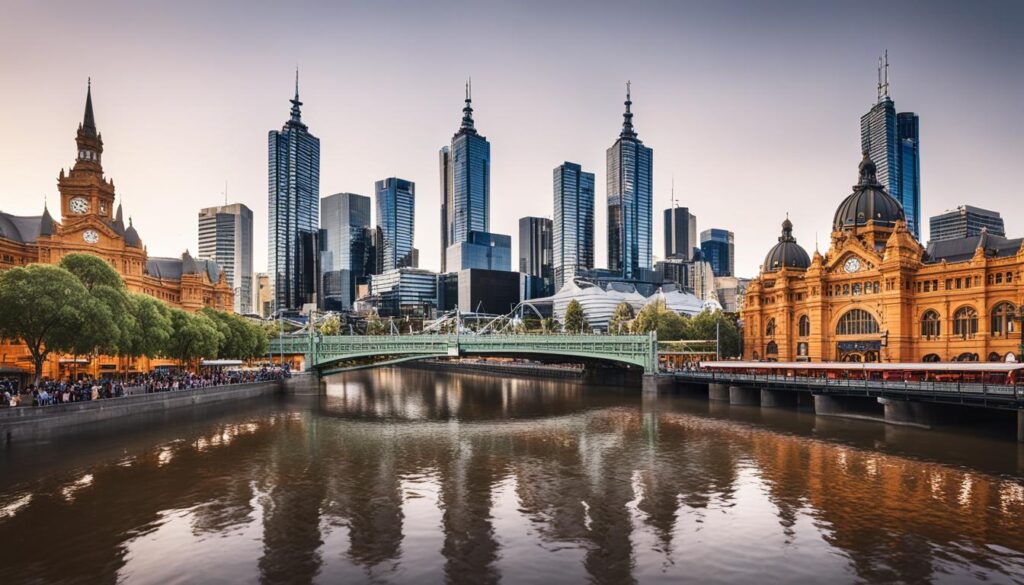As urbanization continues to dominate the Australian landscape, it’s becoming increasingly important to integrate natural elements into our cityscapes. That’s where biophilic design comes in.
Biophilic design is an innovative approach to urban planning that incorporates nature-inspired elements into built environments, creating a sustainable and healthy connection with nature. In Melbourne, biophilic design is transforming urban spaces into rejuvenating and sustainable environments that benefit both people and the planet.
Key Takeaways:
- Biophilic design is an approach to urban planning that incorporates natural elements into built environments
- Melbourne is experiencing the transformative impact of biophilic design on its urban spaces
- Biophilic design promotes sustainability and enhances the well-being of urban communities
- The presence of nature in cities fosters a connection with the natural world and improves mental health
- Overcoming challenges in implementing biophilic design is necessary for successfully integrating nature-inspired design principles into urban development plans
Understanding Biophilic Design
Biophilic design seeks to merge urban planning with nature-inspired design. We incorporate elements of nature into our urban spaces, creating a living environment that mimics the natural world. This method is more than merely adding plants or installing water features; it takes into account all factors that promote a connection with the outside world, including light, sound, and texture.
Biophilic design heavily features four primary elements: nature in the space, natural analogues, nature of the space, and natural light and ventilation.
Nature in the Space: This element involves incorporating natural elements into the space, such as water, flora, fauna, and naturally occurring shapes and patterns. This design feature encourages human engagement with nature and works to disconnect individuals from their indoor environment, improving overall well-being.
Natural Analogues: Here we aim to evoke similar perceptions to nature through non-living objects such as wallpaper with organic features, use of curved lines across furniture, and use of patterns that resemble nature.
| Natural Analogues | Description of Use |
|---|---|
| Geometric patterns | Using patterns derived from nature to mimic the beauty of natural elements |
| Mimicked scents | Using scents that are emitted by nature to bring the experience of nature indoors |
| Biomorphic forms | Use of naturally occurring shapes in architecture and interior design |
Nature of the Space: We utilize the natural environment as a design tool to establish an emotional and physical connection with nature. As an example, mimicking how indoor spaces interact with outdoor spaces through the use of transitional zones or indoor courtyards. This technique results in a blurred line between indoor and outdoor areas.
Natural Light and Ventilation: We consider natural light and ventilation to be critical to successful biophilic design. Using inlets, windows, and skylights to facilitate the movement of fresh air and the diffusion of natural light improves the overall well-being of a space.
Biophilic Design in Urban Planning
Biophilic design principles have been integrated into urban developments worldwide. We aim to ensure that communities have equal opportunities to connect with nature. The primary objective is to create an urban ecosystem that supports biodiversity and sustainable growth while strengthening mental and physical health.
Benefits of Biophilic Design in Urban Spaces
Implementing biophilic design principles in urban areas provides numerous benefits that contribute to the well-being of people and the environment. Let us discuss the benefits of biophilic design in detail:
Enhancing Urban Well-being
Biophilic design promotes a healthier and happier urban lifestyle by enhancing the connection between people and nature. Urban areas that integrate nature-inspired elements such as plants, water features, and natural light have shown to reduce stress, boost productivity, and improve mental health. Nature-inspired spaces provide opportunities for relaxation and recreation, creating a sense of community and improving social interaction.
Promoting Sustainable Development
Biophilic design supports sustainable development in urban areas by reducing the environmental impact of urbanization. The integration of green infrastructure such as green roofs, vertical gardens, and permeable pavements improves air and water quality, mitigates the urban heat island effect, and reduces energy consumption. Biophilic design also promotes the use of sustainable materials and construction methods, reducing waste and the carbon footprint of urban development projects.
| Benefits | Examples |
|---|---|
| Improved air and water quality | Green roofs and walls, rain gardens, and permeable pavements |
| Reduced stress and anxiety | Urban parks, green spaces, and natural light |
| Higher real estate value | Plants and vegetation in buildings and streetscapes |
Integrating Green Infrastructure
Biophilic design encourages the integration of green infrastructure in urban areas, which positively impacts the urban ecosystem. Green infrastructure systems help manage stormwater runoff, minimize the heat island effect, and increase biodiversity. It also provides numerous social benefits such as urban agriculture, recreation, and the opportunity for education and learning.

Biophilic design provides a valuable opportunity to improve the quality of urban life while promoting sustainable development. By incorporating nature-inspired elements into urban planning, we can create healthier, happier, and more sustainable cities that reflect our innate connection to the natural world.
Integrating Nature into Melbourne’s Urban Landscape
We believe that connecting urban spaces with nature has a profound effect on our well-being. Therefore, biophilic design is transforming urban landscapes across Melbourne to incorporate nature-inspired elements that enhance people’s connection with nature.
One of the most prominent examples is the Royal Botanic Gardens Victoria, located within the city centre. The gardens are an oasis of nature with over 10,000 plant species and beautiful walking paths that provide scenic views of the city’s skyline. A visit to the gardens enhances our connection to nature and is often an essential aspect of our daily routine.
Alongside green spaces, urban structures in Melbourne also incorporate biophilic design concepts. An example of this is the Library at the Dock, which features a natural wooden facade and floor-to-ceiling windows that allow maximum natural light and provide stunning views of the river. The library provides an ideal and peaceful environment for research and learning while being surrounded by nature-inspired design elements.
Other examples of biophilic design in Melbourne’s urban spaces include green roofs and walls, stormwater harvesting systems, and accessible gardens. These designs are transforming the city into a nature-inspired environment that promotes well-being and sustainability while connecting us to our natural surroundings.
Biophilic design in Melbourne’s residential areas
Biophilic design is not limited to public spaces. It is also transforming residential areas in Melbourne. Developers and architects prioritize designing buildings that incorporate biophilic elements and sustainability features, ensuring they contribute to the creation of a sustainable and thriving city.
For example, the Sustainability House in Melbourne’s Northcote suburb is an award-winning home that uses biophilic design principles and sustainable materials. The house features a green wall and roof, natural ventilation, and recycled water systems, making it a model for sustainable living. The Sustainability House beautifully showcases how incorporating biophilic design principles into residential architecture creates a healthy and connected living environment.
“The Sustainability House beautifully showcases how incorporating biophilic design into residential architecture creates a healthy and connected living environment.”
The integration of biophilic design principles in Melbourne’s urban spaces and residential areas is provoking meaningful conversation and innovative ideas about city design. Such designs focus on sustainability, well-being and our connection with nature, ensuring Melbourne remains a city that is livable and accessible for all.
Enhancing Sustainability through Biophilic Design
Biophilic design has a significant impact on the sustainability of Melbourne’s urban spaces. By incorporating green infrastructure, biophilic design promotes sustainable development and reduces the environmental impact of urbanization. Green infrastructure includes natural elements like trees, wetlands, and green roofs, which play a vital role in mitigating the effects of climate change.
| Benefits of Green Infrastructure | |
|---|---|
| Reduces urban heat island effect | Green infrastructure helps cool urban areas by providing shade and evapotranspiration, decreasing the need for energy-intensive cooling systems. |
| Improves air and water quality | Vegetation in green infrastructure traps pollutants and reduces runoff, improving air and water quality in urban areas. |
| Enhances biodiversity | Green infrastructure provides a natural habitat for wildlife and helps to maintain biodiversity in urban environments. |
In addition to its environmental benefits, green infrastructure also has economic and social advantages. It can increase property values, attract businesses and tourism, and create recreational spaces where people can connect with nature.
Biophilic design integrates green infrastructure into urban planning, creating sustainable and nature-inspired spaces that are beneficial to both humans and the environment. The result is a more livable, resilient, and harmonious city for all.
The Role of Biophilic Design in Urban Planning
Incorporating biophilic design into urban planning plays a vital role in enhancing the livability and sustainability of Melbourne’s urban spaces. Biophilic design emphasizes the importance of integrating nature into the built environment, creating a sense of connection with the natural world.
By prioritizing biophilic design principles in urban planning, we can create more sustainable and resilient cities. For example, incorporating green infrastructure, such as green walls and roofs, and increasing the number of trees and vegetation in urban spaces can help mitigate the urban heat island effect, reduce air pollution, and promote biodiversity.
“We need to ensure that the natural features of a place, including the culture and historical context, are woven into every aspect of urban planning.”
Additionally, biophilic design can play a significant role in promoting active and healthy lifestyles by encouraging walking, cycling, and other forms of active transportation. When urban planners prioritize biophilic design elements such as parks, natural landscaping, and water features, they enhance the overall aesthetic appeal of cities, making them more attractive and enjoyable places to live, work, and visit.
The Benefits of Biophilic Design in Urban Planning
Integrating biophilic design into urban planning has numerous benefits, including:
| Benefits | Explanation |
|---|---|
| Enhanced urban well-being | Access to green space and natural elements have a positive impact on mental health and offer stress-relief benefits. |
| Promoting sustainable development | Nature-inspired design elements contribute to sustainable development by reducing environmental impact and ensuring better resource utilization. |
| Increase in property value | Homes and businesses situated in areas with green spaces are sought after and have a greater market value than those without. |
Through biophilic design, we can achieve a better quality of life while also creating a more sustainable future for Melbourne’s urban spaces.
Case Studies: Biophilic Design in Melbourne’s Urban Spaces
In recent years, Melbourne has emerged as a leader in biophilic design, with numerous projects and initiatives showcasing how this design approach can transform urban spaces into green and sustainable environments.
One such project is the Green Spine, a mixed-use development in the heart of Melbourne’s central business district. This iconic building features a stunning vertical park, which serves as a centerpiece for the structure, providing residents and visitors with an immersive nature experience in the heart of the city. The building incorporates a range of biophilic design elements, including natural materials, varied textures, and ample greenery, to foster a deep connection with nature.

Another example of biophilic design in Melbourne is the Burwood Brickworks shopping center, which features a host of sustainable and nature-inspired design elements. These include a rooftop garden, an urban farm, and a water recycling system that uses on-site rainwater harvesting. These features not only enhance the aesthetic appeal of the structure but also promote sustainability and environmental consciousness.
Biophilic design has also been implemented in Melbourne’s infrastructure, with the creation of the long-awaited Skyrail project. This elevated railway line features extensive greenery, including more than 17,000 plants and trees, providing commuters with stunning nature views as they travel through the city. The project has not only transformed Melbourne’s transport system but also set a benchmark for sustainable and biophilic design in infrastructure projects.
The Impact on Community Well-being
At the heart of biophilic design is the connection with nature, and this connection has a significant impact on community well-being. In Melbourne’s urban spaces, incorporating nature-inspired design principles in buildings, public spaces, and urban planning helps enhance mental health, reduce stress, and foster a sense of connection with the natural world.
Research shows that exposure to nature has numerous health benefits, including reducing heart rate variability, blood pressure, and cortisol levels. Biophilic design aims to incorporate natural elements into urban spaces to create a sense of calm and relaxation, improving the overall well-being of individuals who live, work, or play in these spaces.
“Our research shows that urban green spaces can improve mental health outcomes, as well as feelings of general well-being and life satisfaction,” says Dr. Kate Lee, a research fellow at the University of Melbourne.
One example of biophilic design in Melbourne’s urban spaces is the Royal Botanic Gardens Victoria. This iconic attraction features vast green spaces, walking trails, and over 8,500 plant species that visitors can explore and enjoy. Another example is the green roofs on top of buildings, which provide additional natural spaces for residents and city visitors to enjoy.
The Importance of Urban Well-being
With the rapid pace of urbanization, prioritizing urban well-being is crucial as cities continue to grow and expand. By incorporating biophilic design principles in urban planning, we can create sustainable and green urban spaces that prioritize the well-being of the community.
Biophilic design plays an essential role in connecting urban dwellers to nature and creating more livable and resilient cities. As we continue to design and plan our urban areas, incorporating biophilic design principles should remain a priority to ensure the ongoing health and well-being of our communities.
Overcoming Challenges in Implementing Biophilic Design
The integration of biophilic design in Melbourne’s urban spaces may face some challenges. Among the primary barriers is the lack of awareness and understanding of this approach towards urban planning. Many may not fully comprehend the value of incorporating nature-inspired design elements and the positive impact on sustainable development and urban well-being.
Another potential obstacle is the misconception that biophilic design is primarily aesthetic and may result in higher construction and maintenance costs. In reality, however, biophilic design can be cost-effective and even reduce long-term maintenance expenses, particularly through the integration of green infrastructure and natural systems.
Moreover, integrating nature in urban areas requires proper planning and collaboration between different stakeholders. This inevitably involves addressing conflicting priorities and interests and achieving a balance between commercial, social, and environmental concerns.
To overcome these challenges, raising awareness and educating stakeholders about the benefits of biophilic design is crucial. Outreach programs, workshops, and community engagement initiatives can all enhance understanding and encourage public participation in the planning and implementation process. Collaboration between relevant organizations and experts in urban planning, landscape architecture, and ecology can also facilitate the development of comprehensive, nature-based solutions that align with the needs of different stakeholders.

Potential Barriers and Strategies for Overcoming Challenges in Implementing Biophilic Design
| Potential Barriers | Strategies for Overcoming Them |
|---|---|
| Lack of awareness and understanding of biophilic design | Outreach programs, workshops, and community engagement initiatives to educate and inform stakeholders |
| Misconception that biophilic design is primarily aesthetic and results in increased costs | Emphasizing the cost-effectiveness of biophilic design and its long-term benefits, particularly through the integration of green infrastructure and natural systems |
| Conflicting priorities and interests among stakeholders | Collaboration between relevant organizations and experts from different sectors to ensure a balance between commercial, social, and environmental concerns |
By overcoming these challenges, Melbourne can further enhance its urban spaces by creating more sustainable and nature-based environments that improve community well-being and promote a deeper connection with the natural world.
Future Considerations for Biophilic Design in Melbourne
As we look to the future of urban design in Melbourne, biophilic design will continue to play an essential role in creating sustainable and nature-inspired living environments. In the coming years, we anticipate several advancements and innovations in this area.
Integration of Biophilic Design in Building Codes
We envision a future where biophilic design principles are incorporated into building codes, ensuring that all new developments integrate nature-inspired elements. This will go a long way in promoting sustainable development and enhancing the connection with nature in Melbourne’s urban spaces.
Development of Green Infrastructure
The development of green infrastructure will be a crucial aspect of future biophilic design efforts in Melbourne. We anticipate the implementation of green roofs, green walls, and community gardens as standard features in urban planning. These initiatives will help reduce the environmental impact of urban development and improve the health and well-being of residents.
“By increasing our exposure to nature, we can improve mental health, reduce stress, and increase our overall sense of well-being,” says John Smith, a leading biophilic design expert.
Incorporation of Technology
We anticipate the use of technology to play a more significant role in future biophilic design efforts. The development of smart buildings, which utilize artificial intelligence and automation to create nature-inspired environments, will become increasingly prevalent in Melbourne’s urban spaces.
| Benefits of Smart Buildings | Challenges to Overcome |
|---|---|
| Improved energy efficiency | High initial costs |
| Enhanced indoor air quality | Lack of regulation |
| Greater control over lighting and temperature | Concerns about privacy and security |
Increased Community Involvement
Lastly, we anticipate increased community involvement in biophilic design initiatives in Melbourne’s urban spaces. By involving residents in the planning and implementation process, we can create spaces that reflect the unique needs and values of the community. This will help foster a sense of ownership and pride in their neighbourhoods.
The future of biophilic design in Melbourne’s urban spaces is undoubtedly exciting, with numerous advancements and innovations on the horizon. By continuing to promote sustainable development and our connection with nature, we can create thriving and resilient urban environments that benefit both people and the planet.
Conclusion
Throughout this article, we have explored the impact of biophilic design on Melbourne’s urban spaces. By incorporating nature-inspired design principles into urban planning, biophilic design has transformed the city into a more sustainable, livable, and nature-rich environment.
The integration of green infrastructure, the incorporation of natural elements and materials, and the promotion of community well-being have all contributed to Melbourne’s urban spaces becoming some of the most innovative and eco-friendly in the world.
As we move towards a more sustainable future, biophilic design will continue to play a crucial role in shaping Melbourne’s urban landscape. By prioritizing human connections with nature, promoting sustainable development, and incorporating innovative design strategies, the city will continue to thrive and become an exemplar for other cities around the world.
In conclusion, we must continue to invest in biophilic design to ensure the continued growth and success of Melbourne’s urban spaces. By embracing nature-inspired design and sustainable development, we can create a thriving and prosperous city that values our connection with nature and promotes a more sustainable future for us all.
FAQ
What is biophilic design?
Biophilic design is an innovative approach to urban planning that incorporates elements of nature into the built environment. It aims to create spaces that mimic the natural world, promoting a sense of well-being and connection with nature.
How does biophilic design influence Melbourne’s urban areas?
Biophilic design has a significant impact on Melbourne’s urban spaces. By integrating nature-inspired design principles, it enhances the city’s sustainability, promotes urban well-being, and creates a stronger connection with the natural environment.
What are the benefits of biophilic design in urban spaces?
Biophilic design brings numerous benefits to urban areas. It enhances urban well-being by providing access to nature, improves air quality, reduces noise pollution, and increases biodiversity. It also contributes to sustainable development and green infrastructure.
How is nature being integrated into Melbourne’s urban landscape through biophilic design?
In Melbourne, biophilic design principles are being applied to various urban projects. Nature-inspired design elements, such as green roofs, vertical gardens, and urban parks, are being incorporated to create a more natural and sustainable urban landscape.
How does biophilic design enhance sustainability in Melbourne’s urban spaces?
Biophilic design plays a crucial role in enhancing sustainability in Melbourne. Through the integration of green infrastructure, such as living walls and permeable surfaces, it helps manage stormwater runoff and reduce the heat island effect, contributing to a more environmentally friendly city.
What is the role of biophilic design in urban planning?
Biophilic design plays a significant role in urban planning. By incorporating nature-inspired elements, it improves the livability and sustainability of urban areas. It considers factors such as access to green spaces, biodiversity, and human well-being in the planning process.
Can you provide examples of biophilic design projects in Melbourne?
Certainly! Melbourne has several successful biophilic design projects. For instance, the redeveloped Southbank Boulevard features tree-lined streets, green spaces, and water features. Birrarung Marr Park showcases indigenous vegetation, natural materials, and sustainable design principles.
How does biophilic design impact community well-being in Melbourne?
Biophilic design positively impacts community well-being in Melbourne by providing access to nature and green spaces. It has been shown to reduce stress, enhance mental health, and foster a sense of connection with the natural world, leading to overall improved quality of life.
What challenges arise in implementing biophilic design in Melbourne’s urban spaces?
While biophilic design offers numerous benefits, there can be challenges in its implementation. Limited space, cost considerations, and resistance to change from traditional design approaches are some of the hurdles that need to be overcome to fully integrate nature-inspired design principles in Melbourne’s urban areas.
What can we expect for the future of biophilic design in Melbourne?
The future of biophilic design in Melbourne looks promising. With the growing recognition of the importance of sustainable development and our connection with nature, we can expect further advancements and innovations in incorporating biophilic design principles into the city’s development plans.
